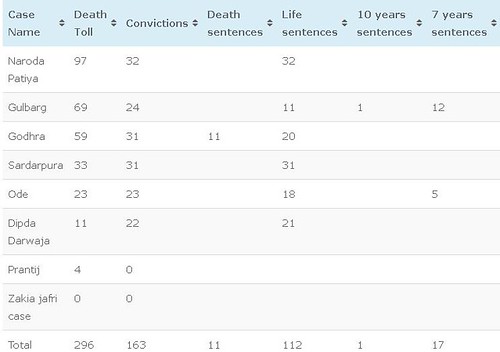By Nirjhari Sinha, TruthOfGujarat.com,
Finally, the sentencing in the Gulbarg case is out. Finally, some of the guilty have been punished. But how did our justice system fare? Did they actually deliver justice? Let’s try to answer this question via certain facts and figures. After the Godhra train carnage on 27th February 2002, for several months starting 28th February, 2002, innocent people were killed all across the state of Gujarat. In view of the plea filed by the National Human Rights Commission (NHRC) before the Supreme Court of India, stating that free and fair trial was not possible within Gujarat and many civil liberty organizations collectively complained about bias and faulty investigation by Gujarat police, Supreme Court appointed a Special Investigation Team (SIT) in 2008 headed by former IPS R.K. Raghavan. Nine most important cases of rioting including Godhra train burning case were assigned to the SIT.
Out of the 9 cases assigned to SIT, with the announcement of the Gulberg verdict, trial in 8 of the cases has now been completed, though appeals before higher courts are still pending. The trial in the Naroda Gaam case where 11 people were killed is still in progress. We first want to present the data regarding arrests, deaths, sentencing in these various cases.

Here are certain facts regarding the rioting and court cases that followed the Godhra training case
1. VHP which gave a bandh call, which was completely illegal, was never charged as conspirator in any case by SIT lead by Raghavan. This is even after a huge chunk of VHP cadre was out on the streets branding their swords and trishul and initiated the attack on the minorities.
2. Except Naroda Patiya case, all other cases including Dipda Darwaja case and Gulberg case, all prominent BJP leaders were acquitted due to lack of evidence or because the prosecutor could not prove the case. Even in Zakiya Jafery case, Narendra Modi was given a clean chit.
3. A special trial court in the 2002 Prantij British nationals’ murder case acquitted all the six accused on the grounds that the prosecution failed to prove the allegations.
4. Across all the 9 cases, only in one case of Dipda darwaja was one police person punished with just a one year sentence. Thus across 9 cases which resulted in ___ deaths with phone call records and ground reports suggesting clear connivance of police with the rioting mob, only 1 policeman got a sentence.
5. Apart from Godhara train carnage in which the judge suggested that there was a criminal conspiracy, only in two others cases did two women judges namely Justice Jyotsana Yagnik in Naroda Patia and Justice Poonam Singh in Ode village case had the courage to invoke charges of conspiracy against accused. In rest of the cases, SIT failed to prove conspiracy.
6.The harshest judgement was delivered in Godhra train burning case where this case was held to be the rarest of rare case and 11 death sentences were awarded. No death sentences were awarded in any of the other cases. So clearly different yardsticks are used for judging minority and majority accused.
7.Justice Jyotsana Yagnik gave a very strong and bold verdict where she held BJP MLA and Minister Maya Kodnani guilty for conspiracy and gave her sentence for 28 years and Babu Bajrangi for 32 years.
8. Whereas, in case of Gulberg which has second highest life-loss, only 11 life sentences were awarded. Among the cases where there was conviction, Gulberg has the minimum number of life sentences while having the 2nd highest amount of death toll. Moreover, a Riot victim Ehasan Jafri has been projected as a villain cum instigator for alleged firing on the crowd which was attacking the society. Did the crowd that had come to Gulberg society armed with weapons come to do meditation?
9.Including Godhra, totally 163 people have convicted across the above 9 cases till date.
10. It is needless to point out all the cases were investigated by Gujarat police under the supervision of Raghavan.
In conclusion, compared to 1984 Sikh riots or Bhagalpur or any other riots, there are definitely many more convictions in Gujarat Riot cases. However, it is the foot soldiers who have been punished and the rich, mighty and the politically powerful people have not been convicted except in Naroda Patiya case. This speaks a lot about our criminal judicial system which is hugely influenced by political parties and gives the sense that justice is indeed blind. Judiciary being one the three main pillars of democracy in our country, with such injustice in cases across different parts of the country and different eras, it is evident that the Indian democracy keeps failing its citizens, especially the underprivileged and the minorities.
